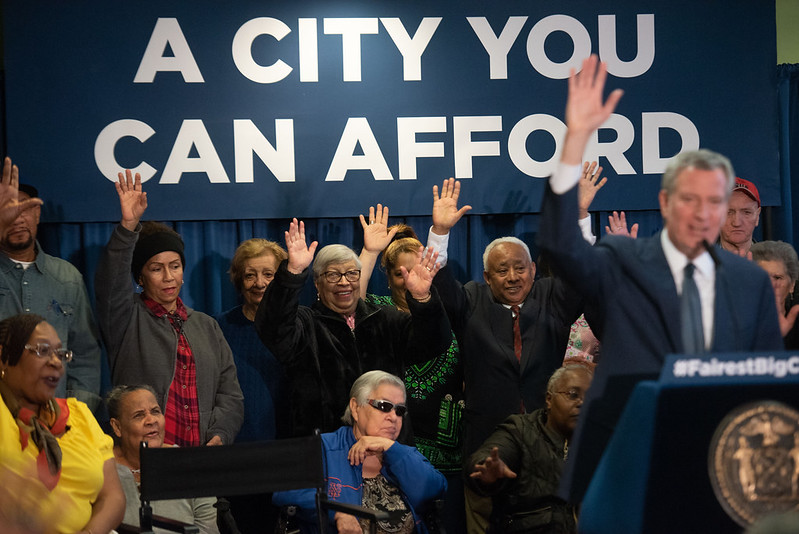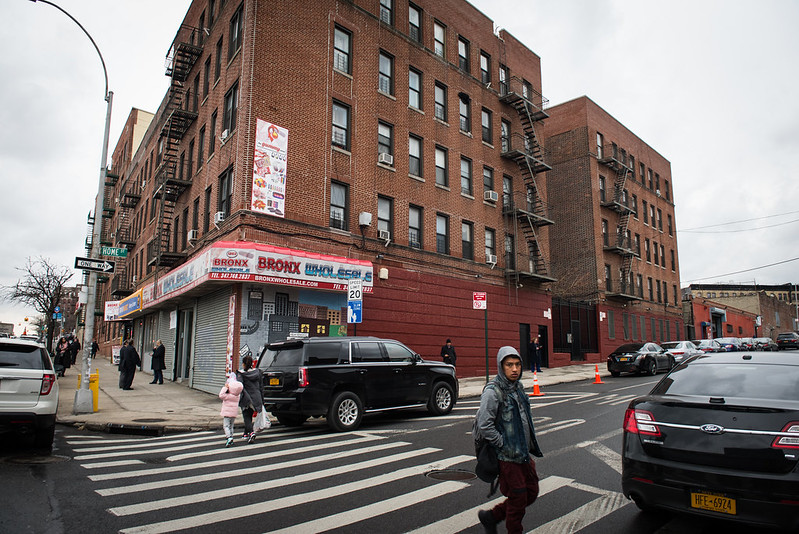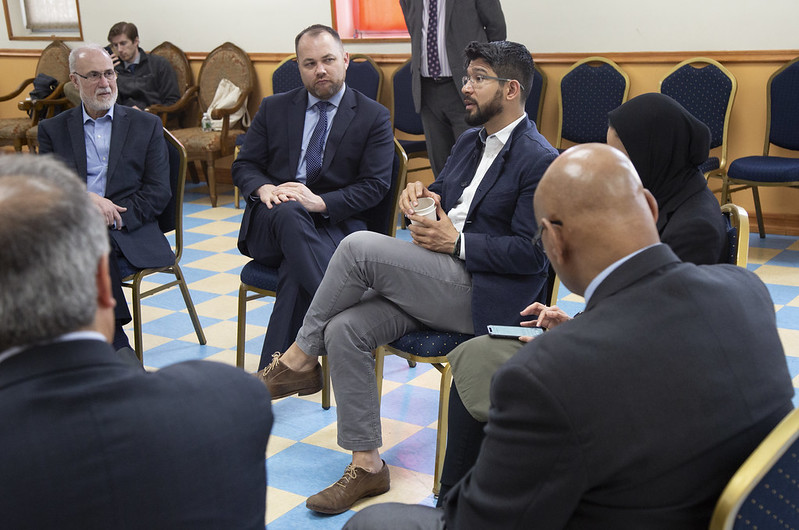The Bronx to SoHo: Pull Your Weight in Addressing the City's Housing and Segregation Crises

Mayor de Blasio with New Yorkers (photo: Michael Appleton/Mayor's Office)
Dear Mayor de Blasio, Manhattan Borough President Brewer, Council Member Chin, and Members and Residents of Manhattan Community Board 2:
My name is John Sanchez, I’m the District Manager of Bronx Community Board 6, a great neighborhood, but also among the poorest in our city. In Bronx CB6, which includes Belmont, East Tremont, and West Farms, there is a 31% poverty rate, a higher than 30% unemployment rate, and 60% of residents are rent-burdened. I love my neighborhood but I can’t fault any of my neighbors for wanting to live in a higher opportunity neighborhood like SoHo or The Village in Manhattan Community Board 2, especially given it would likely help their children’s long-term outcomes for career earnings, health, and educational attainment.
While I am sure many residents in places like Manhattan CB2 finally recognize that Black Lives Matter, in too many parts of our city this call to action stops when it comes to integrating exclusionary neighborhoods and having Black neighbors. I am writing to implore you to take a monumental first step toward equitable integration by supporting the plan presented by Open New York to rezone SoHo and NoHo for thousands of new homes, of which at least 700 would be deeply affordable through the Mandatory Inclusionary Housing (MIH) program.
The rationing of affordable housing development in New York City due to arbitrary zoning rules and local control and the resulting displacement of demand to communities like mine must end.
I actually used to live in SoHo when I was a Resident Assistant at NYU. While the odds of attending NYU as a Black and Latino man from The Bronx are slim but improving, the odds of someone like me building a life in SoHo are six times lower, with only 2% of Manhattan CB2 residents being Black. The neighborhood’s long-standing refusal to construct affordable housing is the main reason for its lack of diversity. While neighborhoods such as Jerome Avenue, Far Rockaway, and East New York have been rezoned during the de Blasio administration, places like SoHo and Riverdale retain their zoning from nearly 40 years ago, limiting the number of people who can live there and preserving their pale “community fabric” instead of fostering beautiful mosaics.
Adding insult to injury, our city’s inequitable land use strategy contradicts the Department of Housing Preservation and Development’s very own guidance, which states “MIH requirements work best in strong housing markets. Rental projects in moderate and weak markets do not achieve sufficient returns to achieve feasibility without subsidies.” Allowing the stronger housing markets like SoHo to build without subsidies would allow low-income areas like my community board to have more subsidy dollars to build more units of housing at deeper levels of affordability.
The fiscal crisis brought on by the pandemic makes changing this dynamic even more urgent - if the city is going to cut $1 billion from our affordable housing construction budget, we must get the most equitable bang for our buck with the funding that’s available.
The pandemic has shown us that viruses don’t recognize the geographic lines that define our land use process. New York is an interconnected city that cannot exist without people of all backgrounds doing their part, especially when it comes to addressing our affordable housing crisis. Whether operating our transportation system, staffing our hospitals, teaching our children, delivering our food, or cleaning our streets, our city would grind to a halt without the essential workers who mostly live in communities like mine. Yet in wealthy neighborhoods like SoHo they’re only welcome to visit when working, shopping, or sight-seeing, but not if they’re looking for a place to live.
If you can accept a food delivery from a New Yorker who doesn’t look like you, you can also embrace them as a neighbor. If you can hire a nanny for your children who looks different from you, you can also embrace their children as classmates of your own children.
Upzoning SoHo for mixed-income housing would be an important next step in building a New York that is united and open to all regardless of background or income. Let’s show the whole city that building more housing is not a burden on any community, but a benefit for us all that should happen throughout the five boroughs.
***
John Sanchez is the District Manager of Bronx Community Board 6 and a candidate for City Council in District 15. On Twitter @NYJohnSanchez.
***
Have an op-ed idea or submission for Gotham Gazette? Email This email address is being protected from spambots. You need JavaScript enabled to view it.
Efforts to End Racism Must Include Dismantling Housing Discrimination

Housing discrimination must be addressed (photo: Edwin J. Torres/Mayor's Office)
In January 2015, I was released from a federal prison in California with the clothes I came in with, a few personal possessions I’d collected over the six years I had been incarcerated, and a bus ticket back to New York City. After a six-day journey home, I found myself subletting a room from a family friend – and as long as the rent was paid on time, they did not ask questions. Living in this apartment allowed me to find employment, cultivate relationships with my family, and continue pursuing my degree at City Tech. Unfortunately, this arrangement did not last.
In 2017, the landlord conducted a criminal background check and proceeded to evict me. Within a few months, I was in a homeless shelter.
Communities of color are disparately harmed by so many systems – particularly the intersection of our criminal legal system and our housing system. As a person of color in America, I am constantly straddling those two systems and the racist laws that sustain them. The incredible protests sweeping across all 50 states (and several countries) are demanding accountability to Black and brown lives — investing away from police and toward structural change. But this change can’t begin and end with police reform. It must also extend to all other systems, especially housing.
After my eviction, I worked tirelessly to find a new home. I called real estate agents, filled out applications, paid for nonrefundable background checks (between $25 and $50 each), put down deposits, and met with landlords. When faced with the question, “Where have you lived for the past five years?” or “Have you ever been convicted of a crime?” I answered honestly: “prison” and “yes.” On paper, I had not existed until my release from prison. Between this and background checks that confirmed my history, prospective landlords deemed me unworthy of safe, stable housing.
My only options were overcrowded, vermin-riddled three-quarter houses, the city’s homeless shelter system, or living on the streets.
For three years now, I’ve been homeless – bouncing between shelters and temporary arrangements with friends and family. Currently, I share a cramped room with my nephew. The apartment is next to a highway and my window looks out onto a cemetery.
Unfortunately, my situation is not an anomaly. Housing options for people with conviction records are slim. The New York City Housing Authority (NYCHA) would be a reasonable option, but NYCHA can exclude system-impacted people from applying, living, or even visiting family and friends in NYCHA housing. In short, people with records are systematically excluded from both private and public housing.
It astounds me that these discriminatory policies persist, especially when research consistently shows that stable housing promotes successful reentry and reduces recidivism. Having a place to call home enables formerly incarcerated people to gain and retain employment, connect with family, and avoid future entanglements with the criminal legal system – all of which contribute to creating safer communities for everyone.
Legislation can fix this problem by prohibiting housing discrimination based on conviction records. Passing such a law will prevent real estate brokers and landlords from refusing to sell, rent, or lease housing to people based on past conviction records. It would mean people like me could finally have a place to call home.
New York has the second-highest rate of homelessness in the United States: roughly 80,000 people in the City do not have a place to call home and are in shelter; tens of thousands more are living in informal arrangements like doubling up with friends or relatives. Research shows that roughly 15% of all incarcerated people experience homelessness in the year prior to admission to prison.
Upon release, formerly-incarcerated people are seven times more likely to be homeless than someone without a history of system-involvement. In 2017, 54% of those released from prisons in the state wound up in a homeless shelter in New York City.
But this is not just a homelessness issue – this is a racism issue. Our mass policing, arrest, and incarceration policies disproportionately target communities of color. As a result, one in three Black adult men has a felony conviction in the United States. The racial disparities in incarceration are particularly stark in New York City, where 90 percent of people in jail are Black or Hispanic.
Every one of those people faces housing discrimination and a hard road back.
When I was released from prison in 2015, I incorrectly assumed that I had paid my debt to society and that I could become a productive, contributing member of my community. Instead, I continue to suffer from the collateral consequences of both a racist criminal legal system and deeply entrenched racism in our housing laws.
A conviction history should be a history – not a life sentence. If we truly want to create lasting changes to our racist laws and systems, we must end racist discrimination in housing once and for all.
***
Devone Nash is a mental health advocate and member of the Fair Chance for Housing Coalition. He lives in New York City and recently graduated from Medgar Evers College with a degree in Psychology.
***
Have an op-ed idea or submission for Gotham Gazette? Email This email address is being protected from spambots. You need JavaScript enabled to view it.
Now More Than Ever, New York City Needs Leaders to Welcome Jobs

Council Member Menchaca & Speaker Johnson (photo: John McCarten/City Council)
All of us who care about New York City – and if you are a regular reader of Gotham Gazette that surely includes you – are worried about its future. COVID-19 has shuttered our economy and seriously impaired the lives and livelihoods of millions of our residents. It is clear that things will never go back to the way they were and that we must turn this disaster into an opportunity to bring back a different, better, fairer city.
But fear of change and the demonizing of ‘development’ risk derailing one of the most important vehicles New York has to generate new jobs and revenue: changes in zoning so that neighborhoods can adjust to new conditions and attract more housing and business. In January I wrote about the risk to the city’s plan to upzone Inwood in Northern Manhattan to provide more housing. Though the plan included a number of community enhancements and had been approved by the area’s City Council member, Ydanis Rodriguez, it was challenged in court by local opposition groups. Fortunately the appellate division correctly reversed the lower court’s decision, but the opposing groups have vowed to appeal.
Now comes another possible derailment of a proposed zoning change: the rejection by Council Member Carlos Menchaca of the proposal to expand Industry City on the Brooklyn waterfront. This plan to turn the area around the vibrantly successful and creative Industry City into a light manufacturing zone was first announced in 2015 and has been reviewed and refined in response to community input. The developers have indicated willingness to sign a community benefits agreement including all of the requirements Menchaca had specified, including removal of hotels from the plan, restriction on the amount of retail space, creation of a manufacturing hub managed by a non-profit, expansion of the existing Innovation Hub to connect more local residents to jobs, support for worker cooperatives and training and research around green manufacturing.
In both the Inwood and the Industry City cases, despite years of community engagement and input, whether through ‘member deference’ which enables the local Council member to veto a project or, failing that, through the courts, vocal groups have been able to sidetrack the projects. The chilling effect of the failure to bring an Amazon headquarters to Queens is being exacerbated just at the moment when we need to be encouraging outer-borough centers of innovation and employment.
Of course every effort should be made to assure that the current residents of the surrounding area benefit from new development, and the Industry City plan adopts this goal. Indeed 57% of the 8,000 jobs already created by Industry City are filled by Brooklyn residents and 37% from the immediate neighborhood. This rezoning would bring an additional $64 million in private investment on top of the $400 million already spent on Industry City revitalization. It would attract new kinds of businesses and pump 15,000 more jobs and $100 million a year in tax revenue into the city’s economy. Projects like this are vital to ensuring a healthy future and the stakes are too high to let a determined minority override the best interests of everyone else.
A few public officials have come forward to defend the Industry City project and urge its approval despite the local Council member’s objection. Two of them wrote convincingly in the Daily News, but they are from other boroughs and are moving on from the Council to other positions at the end of the year. Closer to home, Brooklyn Council Member Robert Cornegy Jr. courageously wrote to his colleagues in the Brooklyn delegation urging them to join him in supporting the Industry City zoning application notwithstanding their colleague’s objections. In a follow up op-ed in the Brooklyn Eagle he summed up the argument:
“In the pre-pandemic world, this was already a precedent-setting example of responsible development in our borough that would have been an important project for Brooklyn’s economic future. Now, in the face of a financial crisis unlike anything since the Great Depression, it is an absolute necessity."
"We find ourselves at a historically precarious junction and it is not an exaggeration to suggest that the City Council is now faced with a decision that will help to determine which economic path our City ultimately takes…This pandemic has forced us to think anew about what’s best for the greater good of our borough, our city and all of our residents – not just those within a few square blocks of a proposed development – and within that context I believe the choice for the City Council on Industry City’s proposal should be clear.”
Bravo! Now what is needed is leadership from city-wide officials who are willing to step up and represent the needs and interests of the entire city. So amid mass unemployment in our city, what does Mayor de Blasio have to say? When first asked about it, he said that because it is a private application his administration doesn’t play a “leading role” and that while jobs are welcomed in New York City, it is really between the developer and the City Council.
The zoning process is overseen by the City Planning Commission, a mayoral agency, which plays a leading role in all of these decisions. The fact that no public subsidies are required for the Industry City project is a plus, not an element that makes it a “private application” that is solely between the developer and the Council. For the mayor to take the position that he has no role in this or any large-scale land-use application unless his administration is the main driving force would be quite an abdication of responsibility.
It seems that he (perhaps urged by someone in his administration) thought it might be better to be slightly more engaged, and a few days later the mayor modified his comments when asked about Industry City again. The traditional deference to the impacted area’s Council member is worth respecting, he said, but added:
“But I do think we have to think about some of the overwhelming dynamics we're dealing with right now. We're in the middle of a pandemic and we've got to get people back to work. We've got to find every way to get livelihoods back to people who need them. So, that needs to be taken into account.”
This is not exactly a ringing endorsement of the Industry City plan, but it is an acknowledgement that the covid crisis should cause City Council members and many others to rethink their priorities and approach to growth, especially jobs. Approving this particular rezoning is the right thing to do and would also serve as a symbol that our elected leaders get that special, hard times call for new approaches. With New York City facing an economic abyss, the mayor has to ratchet up his support and work with the City Council to get the Industry City rezoning over the finish line.
That said, Mr. City Council Speaker, the ball is in your court.
***
Carol Kellermann was president of Citizens Budget Commission from 2008 through 2018.
***
Have an op-ed idea or submission for Gotham Gazette? Email This email address is being protected from spambots. You need JavaScript enabled to view it.




